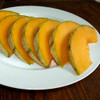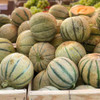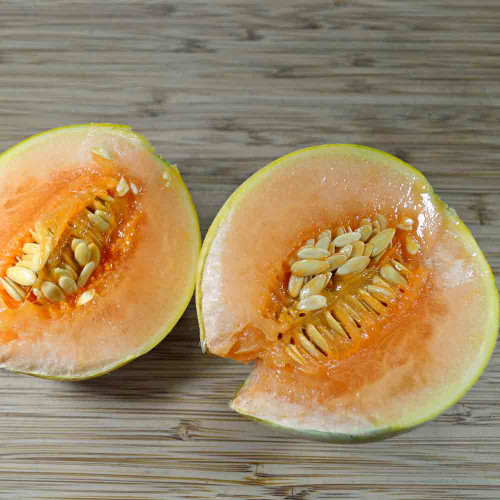Description
Jenny Lind "Swedish Nightingale" Melon – Rediscover Sweetness
This is the story of a melon with such a rich fragrance of summer and a taste so sweet it inspired song – a delightful combination of flavors with more than a touch of showbiz magic.
Our story starts with the Center melon – a local Philadelphia heirloom shrouded in mystery. Its origins are unknown, though it might have been developed sometime in the early to mid-1800s. Interestingly, there are rumors that the Center melon – known for its sweetness and adaptability – was brought to the area by Armenian immigrants.
In 1850, fate stepped in when P.T. Barnum, the grandmaster of spectacle, brought opera singer Jenny Lind, famously known in Europe as the "Swedish Nightingale," to America for a grand tour. Her enchanting voice captivated Americans, igniting a nationwide craze known as "Lindomania." At the height of the craze, a shrewd seedsman noticed a golden opportunity and rebranded the Center melon into the Jenny Lind, forever linking it to the beloved singer. The melon was synonymous with the talented and celebrated performer from that day on.
With its distinctive striped shape and delicate sweetness, the Jenny Lind quickly became a beloved fruit in gardens and markets throughout the Northeast. Its charm and allure captured the hearts and palates of all who tasted it. However, as time passed, newer varieties of fruits gained popularity, and Jenny Lind slowly faded from the limelight.
Luckily for us, dedicated seed savers have preserved its legacy, and now it is ready to make a triumphant comeback in your backyard.
Description
The vigorous vines can grow up to 5 feet – longer in ideal conditions. Their tendrils attach to any support, perfect for vertical gardening on fences or trellises. Training the vines to grow upwards on a trellis or other structure keeps the plant tidy and prevents disease – particularly useful for smaller gardens as it saves space and keeps the fruit cleaner.
Leaves are large and fuzzy with a vibrant, light emerald tint that adds a touch of brightness to the garden while shading the fruit.
Tiny splashes of vibrant yellow blossoms adorn the vines, magnets for various pollinators, especially bees of all kinds, from honeybees to bumblebees and smaller native varieties, drawn to their sweet nectar. As they move from flower to flower, they transfer pollen, essential for developing the melons.
The melon is distinctive with its slightly turban-shaped appearance and ribbed, netted skin. It is around 1-2 pounds and is perfect for smaller gardens and individual servings, ideal for limited refrigerator space. As it ripens, the flesh develops from green-tinged to a pleasing salmon-pink at its core – a promise of its exceptional sweetness.
When young, Jenny Lind melons are deep green and may have subtle ridges on their smooth skin without its characteristic netting.
As the melon ripens, the netting becomes more pronounced and textured. The green skin color fades close to full maturity, and the netting becomes more visible. The turban shape at the blossom end may become more pronounced. You will notice a sweet and inviting scent, which is the signature fragrance of the melon.
History
Melons have been enjoyed by humans for thousands of years, with some of the earliest records of melon cultivation coming from ancient Egypt. Other areas, such as Persia (modern-day Iran) and India, likely enjoyed and selectively bred melons around the same time.
The Jenny Lind melon belongs to the Cucumis melo species, which includes a variety of melons such as honeydew, casaba, and muskmelons. The vast differences between melons within the same species suggest that domestication and selection probably occurred in multiple locations.
While it is difficult to pinpoint an exact location for the cantaloupe's origin, there are a few clues. The name "cantaloupe" is believed to be derived from Cantalupo in Sabina, Italy, where these melons were grown near a papal residence. However, this does not necessarily mean they originated in Italy.
Genetic studies suggest that the cantaloupe's origin is somewhere in the swath of land ranging from South Asia to Africa. This region has a vast diversity of wild and semi-cultivated melon relatives. Ancient farmers were skilled at selecting desirable traits, giving us the delicious melons we enjoy today.
A favorite in the Northeast for its ability to succeed in slightly cooler summers, this melon offers a sweet reward to gardeners with shorter warm seasons. Unlike some varieties that require extended periods of intense heat to ripen fully, Jenny Lind's adaptability means delicious, homegrown melons are possible even in areas where summers are mild or on the shorter side. It is an appealing choice for gardens in cooler regions that might otherwise miss out on the joy of growing their own sweet, juicy melons.
Uses
One of the most perfect flavors you will ever experience is savoring it straight off the vine! Take a sharp knife and spoon to the garden early in the morning. Find a perfectly ripe Jenny Lind melon that slips easily off the vine. Cut it open, taking in the heady fragrance of the salmon-tinged flesh, remove the seeds, and then scoop out a spoonful of the sweet, rich fruit. Don't rush it; let the juices touch your tongue and savor the sweetness first, then the richness. Finally, take a bite, releasing more juice and flavor. You may want to sit down and enjoy this heavenly treat.
A simple drizzle of honey or a sprinkle of fresh mint leaves enhances its natural sweetness and flavor. Scoop out the flesh and serve it with creamy yogurt or a dollop of whipped cream for a delightful treat. You can transform it into a refreshing sorbet or granita on hot days.
Try adding cubed Jenny Lind to summer salads for a burst of sweetness and a unique texture. For a surprising twist, you can even use slightly underripe Jenny Lind in savory preparations like gazpacho or chilled soups. Try infusing fresh slices into water or iced tea for a sweet and refreshing drink.
Companion Planting
Beneficial companions include marigolds, nasturtiums, chives, dill, borage, sunflowers, radishes, and bush beans.
Antagonistic plantings include potatoes, corn, and cucumbers.
Pest and Disease Management
Common problems include infestations of cucumber beetles, squash bugs, aphids, and fungal infections such as powdery mildew and downy mildew.
Solutions to the above issues are mostly common sense – good air circulation is vital, so allow the vines and leaves space to promote airflow; don’t bunch them up. Water your plants with a drip system or at the base to avoid getting the leaves wet, which can lead to disease. If pests appear, consider using organic control options such as neem oil, insecticidal soaps, or beneficial insects. Don't panic if you see pests in your garden - it's a natural part of the ecosystem. Even the most experienced gardeners deal with pests from time to time.
Planting and Growing Tips
To grow melons successfully, remember that they need warm soil and weather. Direct sow after the last frost when soil temperatures are at least 70°F in the morning for the best germination.
Plants need at least 6-8 hours of full sun for maximum sweetness. Plant seeds 1 inch deep and 18 inches apart in rows spaced 6 feet apart to ensure proper spacing. Ensure the soil is well-draining and fertile. Best practices include amending your soil with compost for an extra nutrient boost before planting.
Consistent soil moisture is essential, especially during flowering and fruiting, but avoid waterlogging the roots to keep diseases away. Always check your soil moisture with your finger before watering.
Harvest Tips
Jenny Lind will tell you when it’s ripe with several indicators, including a slight change in skin color from deep green to a lighter, slightly yellowed tone. The sweet, melon-like fragrance will become more intense. The fruit will also slightly soften near the stem where it attaches to the fruit. The prominent "button" at the blossom end becomes even more defined. Finally, with light pressure, the fruit gently slips from the vine where the stem meets the fruit.
Learn More
From the soil to the seed to the food you eat - we'll help you grow your best garden!















